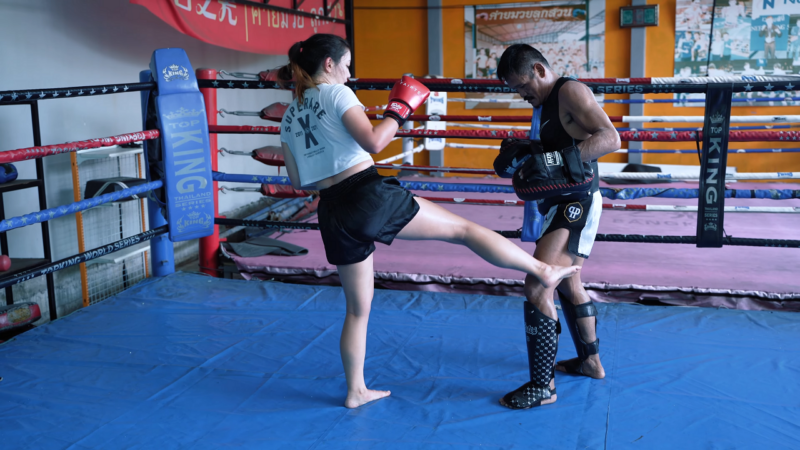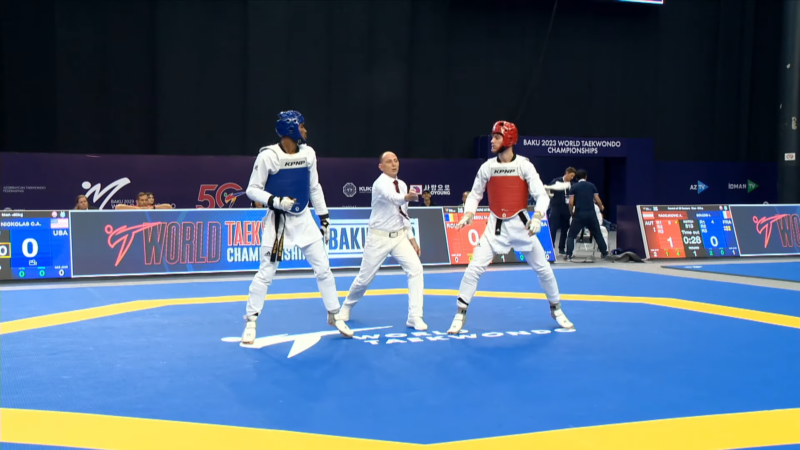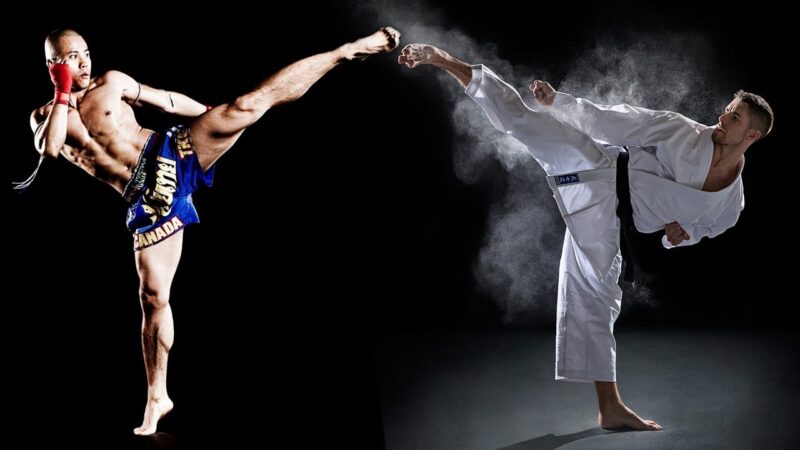Muay Thai and Taekwondo are two prominent martial arts, each with its unique style and philosophy. When choosing a martial art to practice, one critical question often arises: which is more effective?
This debate extends beyond just technique, touching on aspects of fitness, self-defense, and personal development. In this article, you will learn:
- The key differences between Muay Thai and Taekwondo.
- How each martial art performs in self-defense and competitive scenarios.
- Factors to consider when choosing the right martial art for your goals.
Knowing about these elements will help you make an informed decision about which martial arts aligns best with your objectives. Let’s begin.
Historical and Cultural Background

Originating in Thailand, Muay Thai, also known as “The Art of Eight Limbs,” has a history that dates back centuries. It evolved from ancient battlefield tactics to a national sport and a crucial part of Thai culture.
Muay Thai uses the body to mimic weapons of war: the hands become the sword and dagger; the shins and forearms act as armor against blows; the elbow to fell opponents like a heavy mace or hammer; the legs and knees become the axe and staff.
The body operates as one unit, making Muay Thai a holistic and highly effective stand-up striking art. On the other hand, Taekwondo originated in Korea and is characterized by its emphasis on head-height kicks, jumping and spinning kicks, and fast kicking techniques.
It’s a combination of traditional Korean martial arts with influences from Chinese and Japanese fighting styles. Taekwondo became popular internationally and is recognized as an Olympic sport. It emphasizes speed, agility, and precision and is known for its dynamic and visually impressive techniques.
Technical Comparison
Muay Thai is renowned for its powerful strikes and clinch fighting. Practitioners use a combination of fists, elbows, knees, and shins to deliver potent blows. The stance in Muay Thai is more upright to facilitate leg kicks and knee strikes, crucial elements of its arsenal.
Training typically involves heavy bag work, pad training, and sparring, emphasizing endurance, power, and resilience. In contrast, Taekwondo focuses more on precision, speed, and agility. It is characterized by high and fast kicks, often targeting the head.
The stance is generally more side-on, maximizing the reach and power of the kicks. Training often includes forms (patterns of movements known as ‘poomsae’), sparring, and breaking techniques, honing the practitioner’s speed, control, and flexibility.
While both martial arts are effective in their rights, their technical focuses differ significantly. Muay Thai offers a more well-rounded approach to stand-up fighting, utilizing all limbs, whereas Taekwondo specializes in swift and high-reaching kicks.
Effectiveness in Self-Defense

Muay Thai’s practicality in self-defense situations is notable. Its emphasis on close-range combat, powerful strikes, and clinch techniques makes it highly effective in real-world scenarios.
The ability to deliver forceful blows with elbows, knees, and shins can be decisive in self-defense situations. Moreover, the training in Muay Thai often includes dealing with resistance and counters, preparing practitioners for unpredictable situations.
Taekwondo, with its emphasis on kicks and maintaining distance, offers a different approach. The ability to deliver powerful kicks from a distance can be advantageous, especially in situations where maintaining space is crucial.
The speed and precision of Taekwondo can catch aggressors off-guard. However, its effectiveness can diminish in close-quarters combat, where kicks may be less practical. Both martial arts have strengths and limitations in self-defense.
Muay Thai’s versatility makes it more adaptable to various scenarios, whereas Taekwondo’s strategic approach requires more space and distance to be effective.
Performance in Competitive Sports

In the competitive arena, Muay Thai is known for its intense and straightforward fighting style. The scoring system in Muay Thai competitions rewards effective striking, aggression, and control of the ring.
Fighters must demonstrate not only technical skill but also resilience and the ability to absorb and deliver powerful strikes. This makes Muay Thai matches thrilling and dynamic, often featuring a blend of strategic fighting and raw power.
Taekwondo competitions, particularly in Olympic-style formats, focus heavily on scoring points through precise and controlled kicks, especially to the head. Agility, quick reflexes, and the ability to score points without receiving them are key to success in Taekwondo matches.
The sport’s nature makes it a game of speed, accuracy, and tactical movement, often resulting in a visually impressive display of high-flying kicks and rapid footwork.
Fitness and Health Benefits
Muay Thai offers a full-body workout that improves cardiovascular fitness, strength, and flexibility. The rigorous training regime involves a mix of aerobic and anaerobic exercises, making it an excellent choice for those looking to enhance overall fitness.
Practicing Muay Thai regularly can lead to improved muscle tone, endurance, and core strength. Additionally, the mental discipline and focus required in Muay Thai can contribute to stress relief and mental clarity.
Taekwondo, with its emphasis on high kicks and fluid movements, is particularly effective in improving flexibility and balance. The training also enhances agility and coordination as practitioners learn to execute complex kick combinations and movements. Conditioning for taekwondo is quite intense and rigorous.
Regular practice of Taekwondo can lead to improved posture, body awareness, and cardiovascular health. The mental aspects of Taekwondo, including discipline and concentration, can also have positive effects on overall well-being.
Choosing the Right Martial Art for You
Assessing Your Goals and Preferences
When deciding between Muay Thai and Taekwondo, consider your personal goals and preferences. If your interest lies in developing robust striking skills, close combat techniques, and overall physical toughness, Muay Thai might be the right choice.
Its practical approach to self-defense and full-body conditioning makes it a compelling option for those looking for a comprehensive combat sport. On the other hand, if you are drawn to the art of precision, speed, and flexibility and enjoy the strategic aspect of martial arts, Taekwondo could be more suitable.
It’s also a great choice for those who prefer a martial art that is recognized as an Olympic sport, offering opportunities for competitive development at different levels.
Consider Your Physical Condition and Lifestyle
Your physical condition and lifestyle should also influence your choice. Muay Thai can be more physically demanding and may suit those looking for an intense workout.
Taekwondo, while also physically challenging, places a greater emphasis on technique and agility, which might be more appealing to those interested in a martial art that enhances flexibility and coordination.
FAQs
Can beginners start directly with Muay Thai or Taekwondo, or is prior martial arts experience required?
Beginners can start directly with either Muay Thai or Taekwondo. No prior martial arts experience is required, as both disciplines cater to all levels of experience.
Are Muay Thai and Taekwondo suitable for children?
Yes, both Muay Thai and Taekwondo have programs tailored for children, focusing on discipline, respect, and physical fitness in a safe and age-appropriate manner.
How long does it typically take to achieve a black belt in Taekwondo compared to proficiency in Muay Thai?
Achieving a black belt in Taekwondo can take 3-5 years on average, while proficiency in Muay Thai varies greatly, depending on training frequency and personal progress.
Is there a significant risk of injury in practicing Muay Thai or Taekwondo?
As with any physical activity, there’s a risk of injury in both Muay Thai and Taekwondo. However, with proper training, safety gear, and supervision, this risk is minimized.
Can Muay Thai or Taekwondo be practiced for weight loss?
Yes, both Muay Thai and Taekwondo are excellent for weight loss, as they provide intense workouts that burn calories and improve overall fitness.
Are there specific diet recommendations for practitioners of Muay Thai or Taekwondo?
While there’s no specific diet, a balanced diet that supports physical activity is recommended. This includes adequate protein, carbohydrates, and hydration for energy and muscle recovery.
Final Words
Muay Thai and Taekwondo, each with their unique strengths and philosophies, offer more than just self-defense techniques; they provide pathways to physical fitness, mental discipline, and cultural understanding.
Muay Thai excels in powerful, close-range combat and overall physical conditioning, making it ideal for those seeking a comprehensive and practical martial art. Taekwondo, with its focus on speed, precision, and agility, appeals to those who enjoy a more strategic and technique-oriented martial art.
